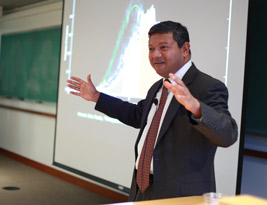Google Energy Chief Calls for a New Industrial Revolution
Arun Majumdar discusses the past, present, and future of energy in McCormick talk
Two and a half centuries ago, Americans burned firewood to warm their homes and whale oil to light their lanterns; energy was generated largely by manual labor and animals. Fossil fuels changed everything, igniting the US economy, swelling its population, and boosting quality of life.
Today, of course, those same practices are threatening environmental and economic turmoil — and forcing scientists to right the wrongs that fossil fuels have created.
“It has been one of the most amazing transformations in human history,” said Arun Majumdar, vice president for energy at Google. “But now we need a new industrial revolution that is sustainable.”

Majumdar, who drives energy initiatives at Google and previously was founding director of the Department of Energy’s Advanced Research Projects Agency-Energy (ARPA-E), spoke to Northwestern students and faculty on November 21 about “Energy and The Industrial Revolution: Past, Present, and Future.”
Since the mid-1700s, humans have emitted an estimated 1 trillion tons into the atmosphere, Majumdar said; based on remaining fossil fuel reserves, we may emit up to 3 trillion more — and likely more, as technologies continue to improve — all within the next 100 years. The value of those fossil fuels: tens of trillions of dollars.
“We ask, do we keep tens of trillions of dollars in the ground… or do we take the tens of trillions of dollars to have expansive growth, and to hell with the economy?” he said. “But it is a false question.”
Majumdar disputed the idea of peak oil — the claim that global supplies of petroleum will dwindle — but insisted that reliance upon it and other fossil fuels must gradually be curtailed in favor of like wind and solar power. Not transitioning comes not only with environmental costs, but also economic: the United States spends $300 billion annually on oil imports, and $100 billion per year is lost due to power outages in our antiquated electrical grid, which is based upon 100-year-old architecture. (The average age of a transformer in the US power grid is 42 years, Majumdar noted, two years older than their projected lifetimes.)
Energy costs for these sustainable technologies are dropping — solar power costs between 12 and 18 cents per kilowatt-hour, while wind is between 5 and 12 — and capacity is drastically improving. But inefficient technology, a lack of infrastructure, and the absence of widespread tax incentives and supportive policies prevents mass adoption.
Some potential game-changing technologies remain far from the mainstream, Majumdar noted, such as projects that seek to engineer plants that can produce oil directly. A team of researchers at Lawrence Berkeley National Laboratory is working to transplant the metabolic pathways of algae — organisms that can be used as a biofuel, but with challenges — into tobacco plants.
“I hope they are successful,” he said, “because then you would have big oil and big tobacco come together and save the world.”
Technologies like these have the potential to reshape the energy future not just of the United States, but the world, Majumdar said.
“I think we should be enabling the rest of the world to do the right thing and not follow in (the United States’) path,” he said. “They might as well have a 21st century grid and not a 20th century grid.”
The lecture was sponsored by the McCormick School of Engineering Dean’s Seminar Series and the Institute for Sustainability and Energy at Northwestern (ISEN).